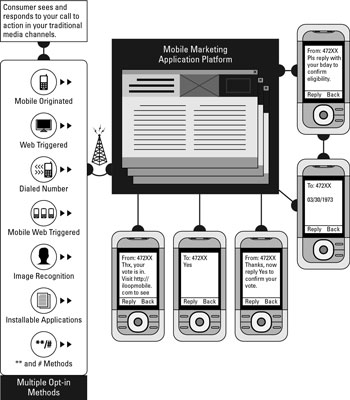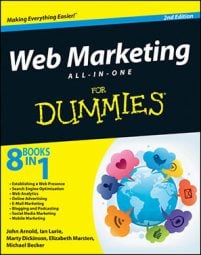In mobile marketing, a request for an opt-in is called an opt-in call to action. You can place an opt-in call to action in any traditional, new, and mobile media channel, including the following:
Television
Print
Radio
Point-of-sale displays
Face-to-face encounters
Outdoor advertising
A web or mobile Internet site
An e-mail
A customer-care call
Online advertising
A dialog pop-up setting in a downloadable application

How to dial and press
Dialing and pressing is all about using the voice channel of the mobile phone. You can encourage people to call a phone number by asking them to “Dial 1-800-XXX-XXXX to experience the sounds of the movie” or “Call 408-XXX-XXXX to listen in on the game,” for example.
You don’t have to answer the calls yourself; you can use an IVR system to ask the caller to make selections. Selection options in an IVR session could be “Press 1 to receive a ringtone,” “Press 2 to get your last five transactions,” or “Press 3 to get the movie listings sent to your phone.”
How to use text
Texting simply means sending and replying to a standard alphanumeric or multimedia message. You can place the call to action in traditional, new, and mobile media by saying something like “Text win to 12345 to enter the sweepstakes.” You can also obtain a mobile subscriber’s opt-in via texting.
Mobile marketing programs and any other programs that use text messaging (such as IVR, Internet, mobile Internet, or applications) must use a CSC to address and route text or multimedia message traffic.
How to snap and scan
Snapping and scanning means taking a picture and scanning a bar code — nearly every phone today has a camera on it.
The camera is a wonderful tool for gathering opt-ins. You can instruct audience members to take a picture of an object — a soft-drink can, a magazine ad, or others that have clearly defined edges — then instruct them to use a scanning application or e-mail/text the picture to your mobile marketing program. When your program receives a picture, it processes the picture and opts the subscriber in to your program.
How to submit
Another great way to invite someone into your mobile marketing program is to present a form on an Internet page or a mobile Internet page, or in an installed application.
Dial an abbreviated code
Two companies — Zoove under the brand StarStar and Single Touch — have developed two alternative opt-in channels; they invite you to place calls prefaced with ** and ##.
Zoove’s method uses the star (*) key on the mobile phone. A mobile subscriber on the Sprint network, for example, can press **267 — that is, **AOL — and the Send/Talk button on his phone (typically, the green button). In return, an AOL promotional mobile Internet site is sent to the phone. Single Touch’s solution works the same way but uses the pound (#) key instead.
Both services are still limited in their deployment across wireless carriers, but you can see the possibilities of these methods of opt-in.
How to execute opt-ins
To leverage text messaging, you need to be familiar with two important text-messaging opt-in classifications:
Mobile originated (MO): A mobile subscriber composes (originates) a message on her phone and sends it to you.
Mobile terminated (MT): A message goes from an application provider’s service to a mobile phone, so the message ends (terminates) on the phone.
How to execute a single opt-in
In a single opt-in, someone sends in an MO and you send an MT back confirming the opt-in. For subscription alerts or ongoing programs, very few carriers support single opt-ins. Mostly, this process is used for one-time interactions; when the initial interaction is done, no future interactions will occur.
How to execute a double opt-in
A double opt-in is typically used to gather an individual’s confirmation. The flow is straightforward:
The user opts in to the program.
The mobile marketing application responds with a text message that asks for confirmation (“Reply y to 12345,” for example).
The user sends the confirmation.
The mobile marketing application processes the request and sends back a welcome message (such as “Thank you. You’re now in the group. To opt out, reply stop, or for help, reply help”).
How to execute a multistep opt-in
You use multistep opt-in when you want to challenge consumers with additional questions before they can participate in your program. For example, you may ask users for their ages if you’re running a program suitable only for users 17 and older. After a user responds to the additional challenges, the interaction may end, or you may follow up by triggering a double opt-in to get expressed consent for future marketing.

